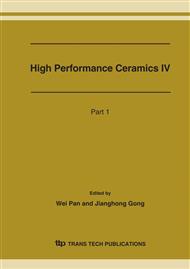p.2579
p.2583
p.2586
p.2589
p.2592
p.2595
p.2600
p.2605
p.2609
Resistance of the Transitional Region of Laser-Clad Coating on Electrolytic Low Titanium Aluminium Alloys to Multiple Impact Loading
Abstract:
A multiple impact loading experiment was designed to investigate the cracking behavior in the transitional regions of laser-clad iron base alloy on an electrolytic low titanium aluminium alloys under multiple impact loading in this study. The concept of TCR (transitional crack ratio) was introduced to evaluate the crack resistance of the transitional regions to multiple impact loading (impact resistance). Results showed that the substrate temperature during laser cladding process and the scanning velocity have significant influences on the microstructure of the transitional regions and then the impact resistances of the laser-clad iron alloy coating. The laser-clad iron base alloy coatings obtained at the substrate temperature within 275 ~ 320°C displayed the best impact resistance. Furthermore, the crack mechanism in the transitional regions was analyzed.
Info:
Periodical:
Pages:
2592-2594
Citation:
Online since:
April 2007
Authors:
Price:
Сopyright:
© 2007 Trans Tech Publications Ltd. All Rights Reserved
Share:
Citation:


